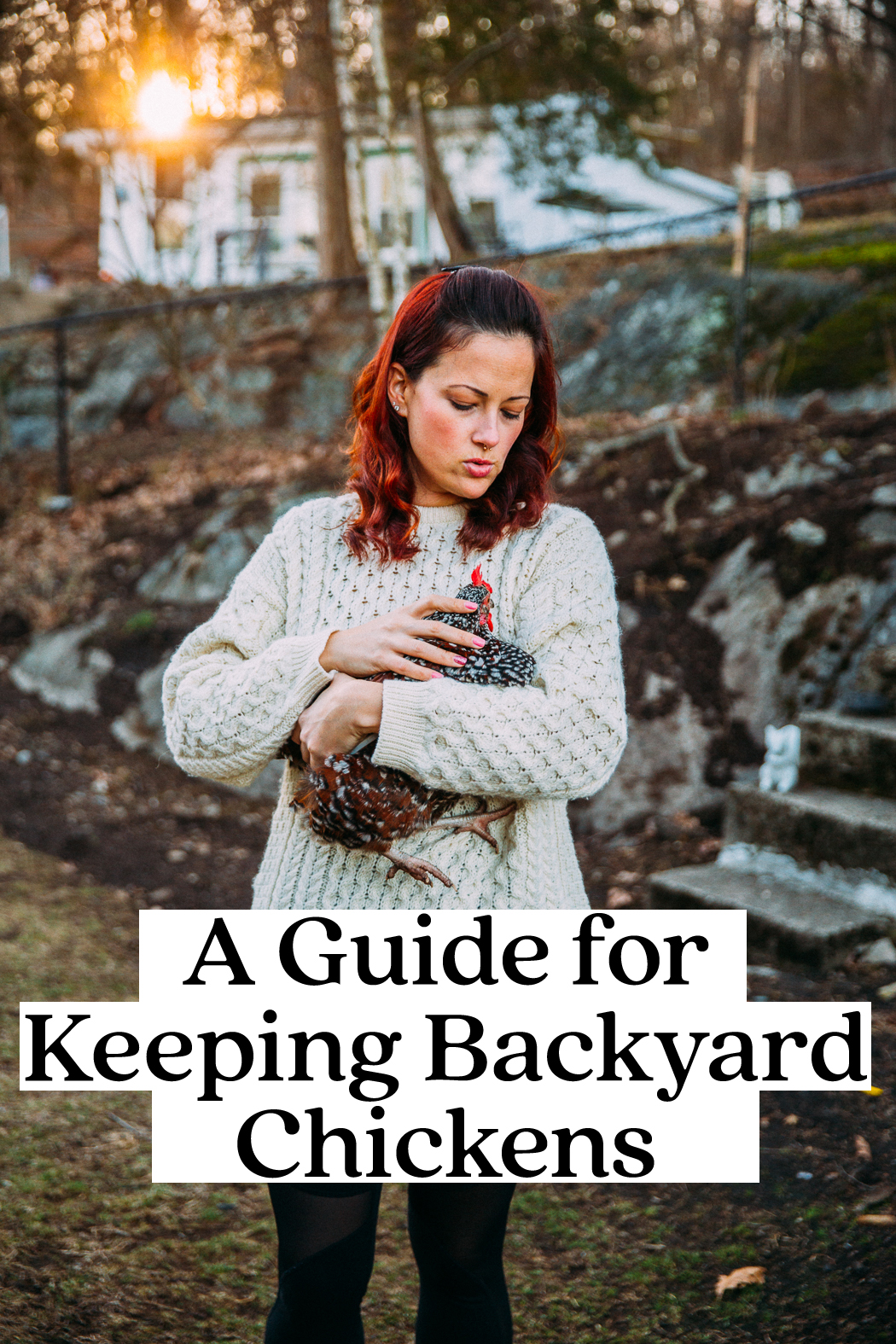
A Comprehensive Guide for Keeping Backyard Chickens

Hello, friends! Backyard chicken keeping seems to be exploding in popularity lately and I love it. It’s so wonderful to see people connecting to the origins of their food. There are many ways to get connected to our food–from keeping a garden, to sustainable hunting and fishing, to buying from local, ethical farmers, to keeping chickens for eggs.
Our family is celebrating our first year anniversary of chicken keeping this month (May 2020). We have learned so much and I am excited to share our experience with you in this post.
Breeds of Backyard Chickens
First, let’s talk about breeds. Before I get started on this topic, note that this post is about keeping backyard chickens for eggs. Thus, I will talk about the breeds from that perspective. Some may want to keep chickens for meat, but I am writing about what we do, which is keeping chickens for eggs. I am also going to write about the four breeds of chickens that we have in our flock of 4. Because our flock is so small and we have only had it for one year, I do not have very much experience with each breed. So I will share the generally accepted information for each breed, along with our personal experiences.
Leghorns
When it comes to the best egg layers, the breed you’ll hear most often is Leg Horns. This breed is a great egg layer and it does well in backyards, so it is an excellent breed to consider if this is your goal.
Leghorn hens lay big white eggs and an average of 280 eggs per year, sometimes reaching 300-320. They mature quickly and have a very good feed to egg conversion ratio. On average, each bird needs around 125 grams of feed daily. Leghorn chickens are very active and effective foragers. They are always willing to work, hunting and scratching. As mentioned earlier, they are prolific layers and rarely go broody. (Brooding is when a hen lays on a clutch of eggs with the intention of hatching them. She stays on the eggs all day except for once a day to go to the bathroom, eat and drink. This is a good thing if you are trying to raise chicks/hatch eggs, but it is not a good thing for egg production as they stop laying during broody periods.)
Leghorns lay throughout the year. They are very easy to rear and they feather up quickly. They can be allowed to free range and are also happy in a run. Their comb is large so care needs to be taken in cold, frosty weather to avoid frostbite. They are pretty noisy and will roost in trees if allowed to free range.
In our experience, the general accepted traits listed above have all been true. Our leghorn (Snow White) is super-friendly, active, flexible and she is our most consistent layer.
One thing to keep in mind is that in our experience, our leghorn is a wanderer. She is always eager to leave our yard and explore (and destroy) our neighbors yards which is a problem if you live in a suburban area. You may not be able free range these chickens safely.
Speckled Sussex
Speckled Sussex chickens became famous as meat birds, because they are ideal for fattening and have pinkish white skin and a long, deep body. However, they are also very good layers. You can expect one adult hen to lay around four or five large, light brown eggs each week. Their most distinctive quality is their incredibly friendly and curious nature. They are the best possible breed to keep as pets, being extremely friendly and wonderful with children. She behaves more like a friendly dog than a chicken. She follows me around the yard and loves to cuddle! These birds can, however, be too curious and like leghorns, they can be prone to wandering out of the yard to explore.
In our experience, our speckled Sussex (Billina) is absolutely true to the expected nature of her breed. She is incredibly friendly. She absolutely loves to be held and pet. She is incredibly curious. She is a wanderer. It is nearly impossible to keep her in the yard. She is an excellent layer, only slightly outperformed by our leghorn.
Orpington
There are various types of orpingtons. We have a chocolate orpington, but there are other varieties including buff, black, blue and others. Hens lay larger light brown colored eggs. They are decent layers and on an average, hens lay about 3-4 eggs per week. It is said that they reach maturity early, but in our flock our orpington reached maturity last. Orpingtons are very fluffy and beautiful. They do well in confinement so keeping them in a run is fine. They are one of the largest breeds and their heavy size prevents them from flying over fences so they are a good breed to keep if you want to keep them fenced in. An important note is that orpingtons are broody. This makes them excellent mothers if you are trying to hatch chicks, but can pose a problem if you want eggs because hens stop laying when they go broody.
In our experience, our orpington (Berta) has held true to most of the breed standards, except for maturing early. She is a decent layer and her eggs are the largest of our flock. She stays in the yard, she is not nearly as curious as our leghorn and Sussex. She is beautiful, fluffy and does well in cold weather. Our greatest challenge with Berta has been her broodiness. At one year old she had her first bout of broodiness. She stopped laying and barely ate or drank at all. We are hoping to avoid further bouts of this by clearing the eggs from the coop each day. I will update in the future about our progress with this.
Easter Egger
Easter egger hens are quiet and calm in nature. They are decent producers. These hens are sought after for their beautiful eggs which can vary in shade from blue to green to olive to aqua and sometimes even pinkish. Some people ask, “Do Easter eggers lay different colored eggs?” The answer is no. Easter eggers eggs do not change color. Like all chickens, whatever color they lay remains the same through their lifetime. In our case, our Easter Egger lays light green eggs and they are always light green. As for personality, Easter eggers are known to be friendly, hardy and easily handled.
In our experience, we have had the greatest challenges with our Easter egger (Goldie). Unfortunately, once we converted our hens from free range to a run enclosure for the spring season, Goldie stopped laying eggs altogether. It has been several months now since she stopped laying. She is also incredibly skittish now and will not allow handling. (Usually mature chickens allow handling easily.) It is said that Easter eggers usually handle confinement well so we don’t know whether this is occurrence is unique to Goldie or if this is typical of Easter eggers. We are currently working on expanding their run space and we are hoping this will help her. I will update again in the future about how this plays out.
Best Breed of Backyard Chicken
With all of this said, I absolutely love our beautiful flock. If you want a variety of chickens and eggs, ours is a great mix. However, my recommendation for “the best breed” depends on your ultimate goal. If your greatest desire is a lot of eggs, I recommend getting leghorn hens. If your greatest desire is friendly, loving hens, I recommend getting speckled Sussex hens. These two breeds are my top recommendations based on our experience. I have also heard a lot of positivity around Rhode Island Reds being excellent layers, however we do not have one in our flock so I can’t speak to them from experience at this time.

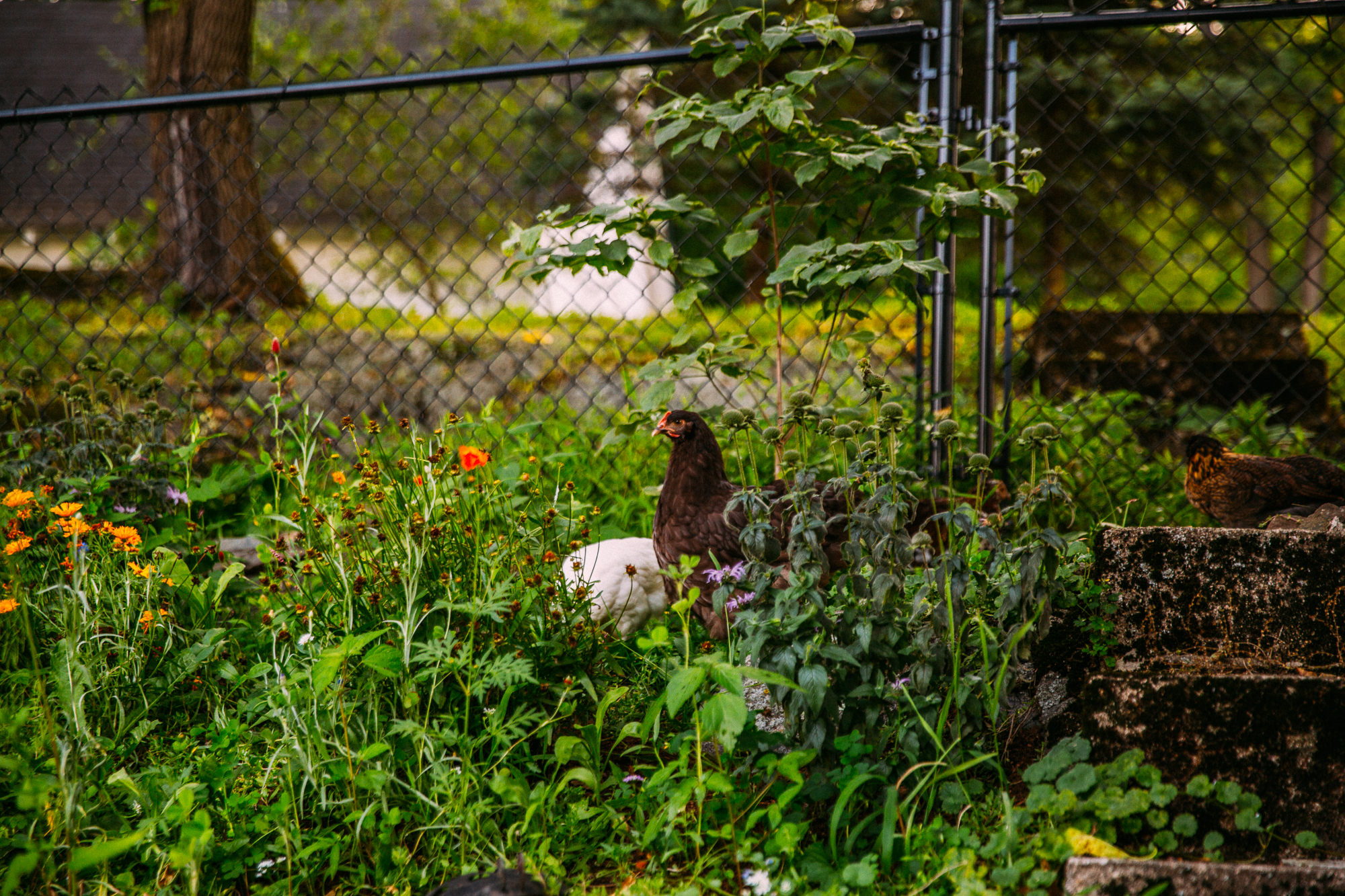
What You’ll Need for Keeping Backyard Chickens
Raising Chicks
Most likely, you will start out with baby chicks. Keeping baby chicks is simple. Your chicks will need chick starter feed and clean water. They will also need a draft-free brooder pen with a red brooder lamp on at all times. Keep the temperature at 92°F (33°C) at 2 inches above the floor. This also reduces picking and cannibalism among chicks.
Once your chicks have feathered out, reduce the temperature by 5°F per week until they are 6 weeks old, then switch their feed from chick starter to grower mash.
Issues you may run into:
Picking — Most picking is the result of overcrowding. Give your chickens lots of space.
Not Eating or Drinking — Young chicks need to be close to water and food at all times. Keep it spread out through their space.
Bullying — Always use red bulbs; injury doesn’t show under red light. Under white light, any bloody spot immediately attracts pecking. Chicks will cheerfully and efficiently peck each other to death.
Suffocation — Block corners of the pen with cardboard to make wider angles that are harder for chicks to pack up in. (You could also make a circular pen.) This prevents suffocation.
Drowning — Ensure that waterers are shallow and cleaned daily to avoid having chicks drown.
Moving Hens to a Coop and Run or Free Range
When your chicks are ready to leave their brooder pen and move into their permanent home, you will need a coop. You can purchase a coop or make one yourself. One medium-sized chicken needs at least 3 square feet of floor space inside the coop. The more space, the happier and healthier the chickens will be; overcrowding contributes to disease and feather picking. You will also need to make sure that there are laying boxes in your coop. It is a good idea to have one laying box per hen.
Outside of their coop, chickens need space to wander, stretch and scratch. Your chickens will need a sizeable chicken run (minimum 8 square feet per chicken) or a whole backyard (free range). More square footage is better. The space should be fenced in order to keep the chickens in and predators out. Chicken-wire fencing works best. The coop, where your chickens will sleep and lay their eggs should be locked at night and completely predator-proof. Our neighbors have lost chickens in the night to foxes and raccoons, and during the day to hawks. You also want to make sure that your girls have access to their coop at all times because that is where they will go during the day to lay their eggs.
When it comes to making the decision to keep your chickens in a run or letting them free range, there is a lot to consider. Free ranging chickens are the healthiest and the happiest. They are allowed to roam and wonder wherever they like. This allows them to forage plants and insects. When our chickens are free ranging, they are producing the most eggs and their egg yolks are a dark, rich yellow. Free ranging is the ideal scenario for a chicken. However, there are a lot of reasons why free ranging is not always the best option for your chickens.
Considerations for Free Ranging
Safety — Predators love to make a meal of chickens. Hawks, eagles, raccoons, foxes, coyotes, domestic dogs and many other animals are all a hazard to your chickens. Vehicle traffic poses another threat. Getting into poisonous plants or garbage poses yet another threat. There are endless safety issues to consider when it comes to free ranging.
Destruction of Property, Gardens and Plant Life — Chickens are destructive and messy. In our first year with our girls, we allowed them to free range 100% of the time. Every inch of our yard, side walks and decks was constantly covered in chicken poop. Our vegetable garden was destroyed. The girls would peck at a tomato a couple of times and then leave it to rot. They also displace every section of mulch, kicking it from garden beds into grass or wherever you don’t want it. They tear up all manner of seedlings and tear flowers apart.
Neighbors — If you have neighbors within any proximity of your home, free range chickens will easily get into their yards and do all of the above. We live in a suburban area and we have neighbors on all sides. Even though we have a 6-foot fence around our yard, three of our girls (Speckled Sussex, Leghorn, and Easter Egger can easily fly over the fence or utilize tree branches to climb over when we clip their wings. Our girls traveled into the yards of neighbors as far as six houses away. Our only girl who never left the yard is our Orpington because she is much less curious than the others and also too big to fly or jump.
For all of these reasons, we sadly had to make the choice to cut back on our girls free-ranging time during certain seasons. In the winter and fall when there is less for them to destroy, they are out more often. We still allow them to free range in the yard during blooming and harvesting seasons, but only under supervision. They spend the rest of their time in a run enclosure which is attached to their coop. As I mentioned earlier, our Easter egger has not adjusted well to the run and we are currently in the process of vastly expanding it and building a compost area for them to dig through. So make sure that if you choose to keep your girls in a run enclosure, it is sufficiently large enough and there is enough for them to do to keep them occupied.
As you can see, when it comes to deciding between a run or free ranging you need to consider many factors, from where you live to the predators in your area to whether you have a garden that you can securely enclose, and so on. There is not a one-size-fits-all solution, but rather a decision to be made based on your unique circumstances. The important thing is that your flock is safe, happy and healthy.
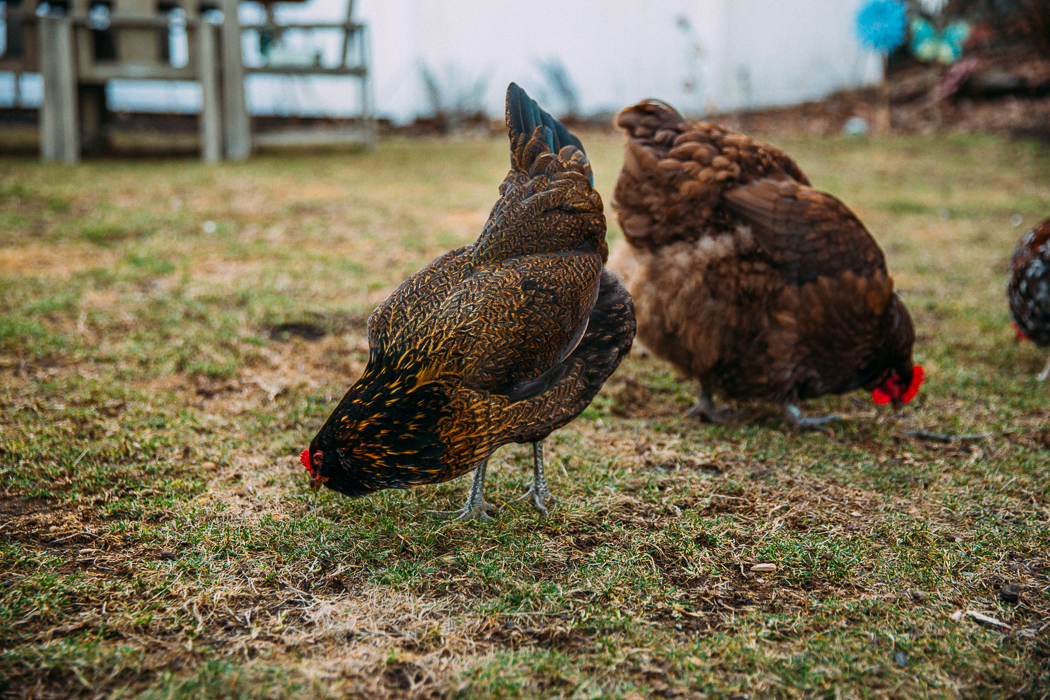
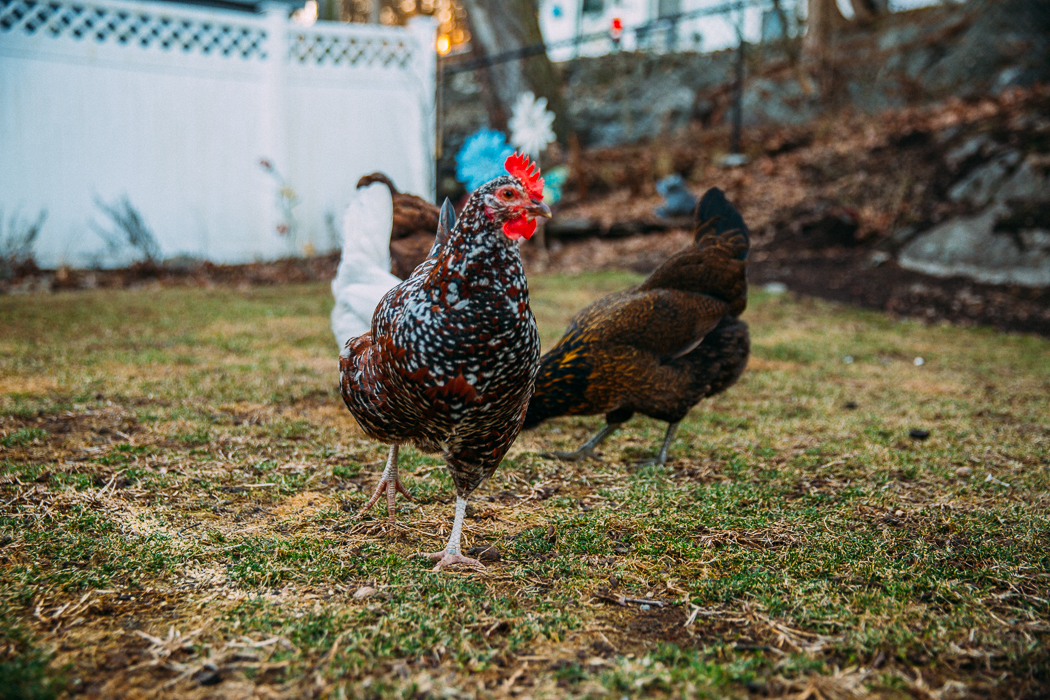
What to Feed Your Backyard Chickens
Once your girls are grown you will want to give them a robust diet of chicken feed and chicken scratch. Chicken scratch is a mix of cracked grains. When purchased commercially, it usually consists of wheat, corn, oats, sunflower seeds, millet and various other seeds. It is not complete nutrition. It keeps them busy and feeds their need for energy found in grains. It is ground coarse, to a size preferred by chickens. For complete nutrition you must also feed your chickens an all around poultry ration or feed. The commercial feeds have wheat, corn, soy, fish or protein meal, vitamin and mineral fortifiers, and binders. This offers a complete meal for your chickens.
Additionally, chickens love table scraps! Nothing gets wasted in our home because our girls absolutely love scraps such as bread, corn, cooked meat, fruit, rice, oatmeal, spaghetti, and vegetables.
Finally you will want to make sure that your girls have constant access to fresh water.

Should I Have a Rooster in My Flock?
When starting a backyard chicken flock, many people will wonder if they should have a rooster. The fact is that hens do not need a rooster in order to lay eggs. Once a hen reaches maturity, she will lay eggs with or without a rooster present. However, if there is no rooster present, her eggs will not be fertilized, therefore baby chicks will not grow inside of the eggs. So the answer to the question of whether or not you need a rooster, depends upon whether or not you want baby chicks.
In our case, we just want eggs, we are not seeking to raise chicks and have more chickens, therefore we do not need a rooster in our flock.
Keep in mind that unlike hens, roosters tend to be very aggressive toward other animals and humans. Also, many towns have ordinances that allow for backyard chickens, but do not allow for roosters because they are very noisy. Roosters don’t just crow in the morning, they crow all day long. Aside from fertilizing eggs, roosters can be helpful in protecting your flock from predators. So there are many things you’ll want to consider before deciding whether or not to add a rooster to your flock.
Keeping Chickens as Pets
Finally, let’s talk about keeping chickens as pets. There are people who keep chickens solely for harvesting their meat and/or eggs, but our family keeps chickens for eggs and for pets. For example, right now, two of our girls aren’t even laying. One has gone broody and one stopped laying months ago when we moved them into their run. Even though those girls are not laying right now, they are still our pets. Hopefully they will start laying again soon, but if they don’t we will keep them as pets. It’s also important to remember that hens egg production will slow down eventually. They will lay steadily for 5 to 7 years, but they can live for 7 to 10 years. It’s important not to take the decision of chicken keeping lightly, it can be a decade long commitment.
When it comes to the question of whether chickens make good pets, my answer is absolutely yes. Once chickens become mature, they are very, very friendly. They love to be held and pet. Depending on the breed, their friendliness varies, but in our experience the Speckled Sussex is an extremely friendly, curious and loving hen. If you are looking for a hen to be a family pet, I highly recommend this breed.
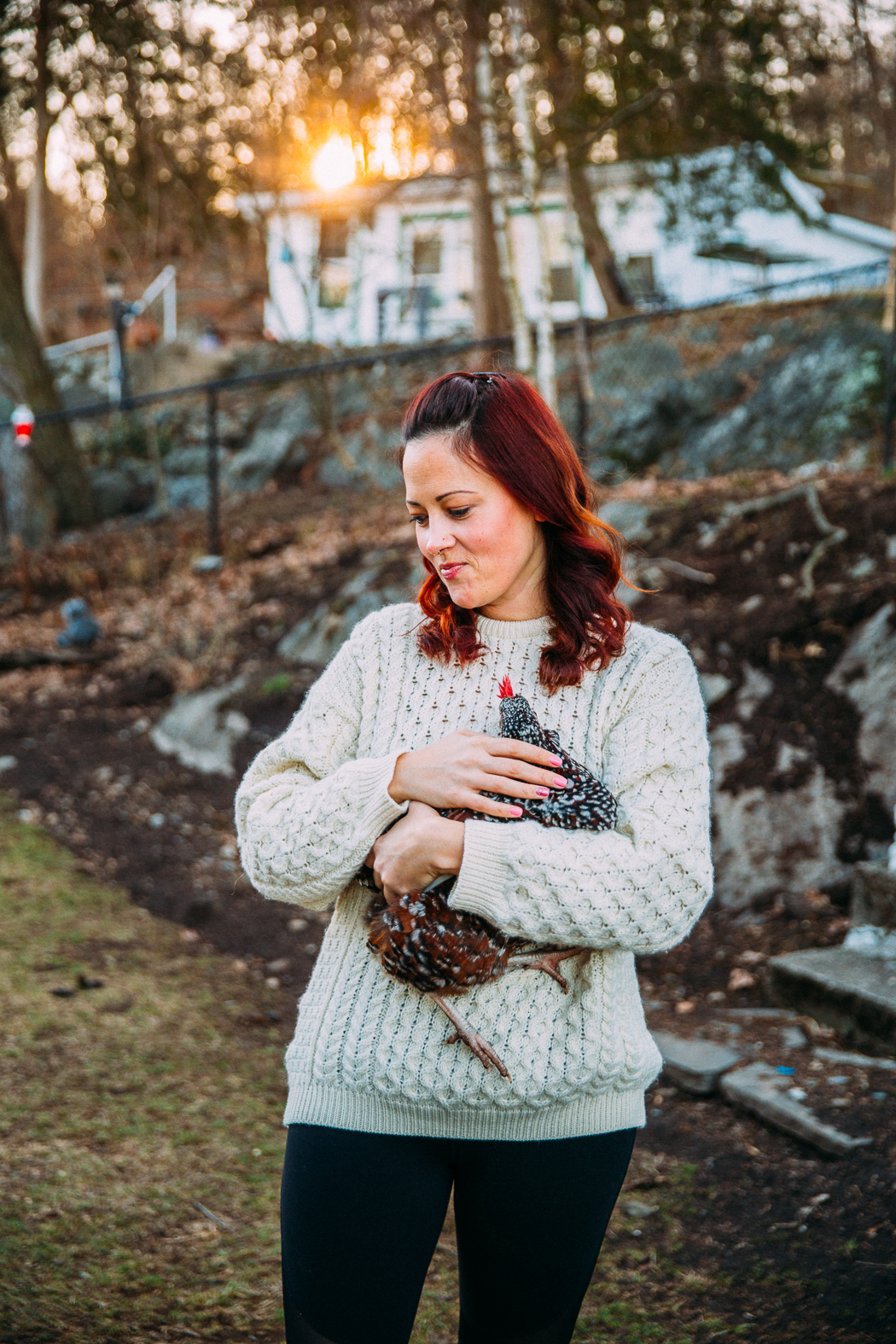
This covers most of the guidance that you will need as you set out to build your own backyard flock. Please let me know if you have anymore questions. I am happy to answer them based on our experience.
Supplies:
Chicken Coop with Laying Boxes
Chicken Run Enclosure
Brooder Pen
Brooder Lamp
Chicken Feed
Chicken Scratch
